If $L=\sin ^{2}\left(\frac{\pi}{16}\right)-\sin ^{2}\left(\frac{\pi}{8}\right)$ and $M=\cos ^{2}\left(\frac{\pi}{16}\right)-\sin ^{2}\left(\frac{\pi}{8}\right),$ then :
- $M =\frac{1}{2 \sqrt{2}}+\frac{1}{2} \cos \frac{\pi}{8}$
- $L=\frac{1}{4 \sqrt{2}}-\frac{1}{4} \cos \frac{\pi}{8}$
- $M =\frac{1}{4 \sqrt{2}}+\frac{1}{4} \cos \frac{\pi}{8}$
- $L=-\frac{1}{2 \sqrt{2}}+\frac{1}{2} \cos \frac{\pi}{8}$
The Correct Option is A
Solution and Explanation
$\left(\because \sin ^{2} \theta=\frac{1-\cos 2 \theta}{2}\right)$
$\Rightarrow L=\left(\frac{1-\cos (\pi / 8)}{2}\right)-\left(\frac{1-\cos (\pi / 4)}{2}\right)$
$L=\frac{1}{2}\left[\cos \left(\frac{\pi}{4}\right)-\cos \left(\frac{\pi}{8}\right)\right]$
$L=\frac{1}{2 \sqrt{2}}-\frac{1}{2} \cos \left(\frac{\pi}{8}\right)$
$M=\cos ^{2}\left(\frac{\pi}{16}\right)-\sin ^{2}\left(\frac{\pi}{8}\right)$
$M=\frac{1+\cos (\pi / 8)}{2}-\frac{1-\cos (\pi / 4)}{2}$
$M=\frac{1}{2} \cos \left(\frac{\pi}{8}\right)+\frac{1}{2 \sqrt{2}}$
Top Questions on Trigonometric Functions
- The integral \[ \int_0^\pi \frac{8x}{4\cos^2 x + \sin^2 x} \, dx \text{ is equal to:} \]
- JEE Main - 2025
- Mathematics
- Trigonometric Functions
- The value of \( \cos \left( \sin^{-1} \left(-\frac{3}{5}\right) + \sin^{-1} \left(\frac{5}{13}\right) + \sin^{-1} \left(-\frac{33}{65}\right) \right) \) is:
- JEE Main - 2025
- Mathematics
- Trigonometric Functions
- If \( \alpha>\beta>\gamma>0 \), then the expression \[ \cot^{-1} \beta + \left( \frac{1 + \beta^2}{\alpha - \beta} \right) + \cot^{-1} \gamma + \left( \frac{1 + \gamma^2}{\beta - \gamma} \right) + \cot^{-1} \alpha + \left( \frac{1 + \alpha^2}{\gamma - \alpha} \right) \] is equal to:
- JEE Main - 2025
- Mathematics
- Trigonometric Functions
- Evaluate the limit: \[ \lim_{x \to 0} \csc{x} \left( \sqrt{2 \cos^2{x} + 3 \cos{x}} - \sqrt{\cos^2{x} + \sin{x} + 4} \right) \] is equal to:
- JEE Main - 2025
- Mathematics
- Trigonometric Functions
Let \( M \) and \( m \) respectively be the maximum and the minimum values of \( f(x) = \begin{vmatrix} 1 + \sin^2x & \cos^2x & 4\sin4x \\ \sin^2x & 1 + \cos^2x & 4\sin4x \\ \sin^2x & \cos^2x & 1 + 4\sin4x \end{vmatrix}, \quad x \in \mathbb{R} \) for \( x \in \mathbb{R} \). Then \( M^4 - m^4 \) is equal to:
- JEE Main - 2025
- Mathematics
- Trigonometric Functions
Questions Asked in JEE Main exam
- Let the line \( x + y = 1 \) meet the circle \( x^2 + y^2 = 4 \) at the points A and B. If the line perpendicular to AB and passing through the midpoint of the chord AB intersects the circle at C and D, then the area of the quadrilateral ABCD is equal to:
- JEE Main - 2025
- Coordinate Geometry
- The number of different 5 digit numbers greater than 50000 that can be formed using the digits 0, 1, 2, 3, 4, 5, 6, 7, such that the sum of their first and last digits should not be more than 8, is:
- JEE Main - 2025
- permutations and combinations
- Two concave refracting surfaces of equal radii of curvature and refractive index 1.5 face each other in air as shown in figure. A point object O is placed midway, between P and B. The separation between the images of O, formed by each refracting surface is:

- An equilateral prism is made of a material of refractive index \( \sqrt{2} \). Find the angle of incidence for minimum deviation of the light ray.
- Two identical symmetric double convex lenses of focal length \( f \) are cut into two equal parts \( L_1, L_2 \) by the AB plane and \( L_3, L_4 \) by the XY plane as shown in the figure respectively. The ratio of focal lengths of lenses \( L_1 \) and \( L_3 \) is:

Concepts Used:
Trigonometric Functions
The relationship between the sides and angles of a right-angle triangle is described by trigonometry functions, sometimes known as circular functions. These trigonometric functions derive the relationship between the angles and sides of a triangle. In trigonometry, there are three primary functions of sine (sin), cosine (cos), tangent (tan). The other three main functions can be derived from the primary functions as cotangent (cot), secant (sec), and cosecant (cosec).
Six Basic Trigonometric Functions:
- Sine Function: The ratio between the length of the opposite side of the triangle to the length of the hypotenuse of the triangle.
sin x = a/h
- Cosine Function: The ratio between the length of the adjacent side of the triangle to the length of the hypotenuse of the triangle.
cos x = b/h
- Tangent Function: The ratio between the length of the opposite side of the triangle to the adjacent side length.
tan x = a/b
Tan x can also be represented as sin x/cos x
- Secant Function: The reciprocal of the cosine function.
sec x = 1/cosx = h/b
- Cosecant Function: The reciprocal of the sine function.
cosec x = 1/sinx = h/a
- Cotangent Function: The reciprocal of the tangent function.
cot x = 1/tan x = b/a
Formulas of Trigonometric Functions:
